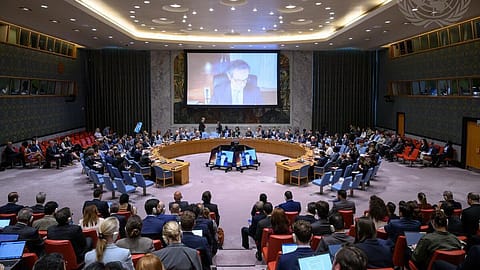Israel-Iran war: IAEA chief Grossi reports 'very significant damage' to Fordow nuclear site after US strikes
The latest strikes on Iran, part of the US' Operation Midnight Hammer, targeted Fordow, Natanz, and Isfahan, using stealth bombers and missiles. Grossi emphasises the need for diplomacy and inspections over military action to prevent nuclear proliferation.

The head of the United Nations nuclear watchdog, IAEA, Rafael Mariano Grossi, said on Monday that given the explosive payload used at Iran’s underground nuclear facility at Fordow, and the extreme vibration-sensitive nature of centrifuges, "very significant damage" is expected to have occurred.
According to the US agency, craters are visible at the Fordow site, Iran’s main location for enriching uranium at 60%, indicating the use of ground-penetrating munitions. This is consistent with statements from the US, which recently conducted "Operation Midnight Hammer," under which it struck three Iranian nuclear sites: Fordo, Natanz, and Isfahan, on June 22, 2025.
The operation was carried out using B-2 Spirit stealth bombers, which delivered bunker buster bombs on Fordo and Natanz. The US forces also used Tomahawk missiles at the Natanz and Isfahan nuclear sites.
The UN agency has reported that at this time, there is no specific information on how much underground damage has been done at these sites, including Iran's biggest site in Fordow.
"Overview of the situation following U.S. attacks: Fordow: craters observed; damage underground cannot yet be assessed; Esfahan: additional buildings hit, inc. tunnel entrances and uranium conversion areas; Natanz: Fuel Enrichment Plant hit with ground-penetrating munitions," says Grossi.
He said IAEA inspectors are in Iran, and they must do their job, including verifying 400kg of uranium enriched to 60%. However, for that, there is a need for a cessation of hostilities. "Any arrangement requires establishing the facts on the ground, which can be done only through IAEA inspections."
Countering the US' call for strikes in Iran, Grossi reiterated that nuclear facilities should never be attacked. "Military escalation threatens lives, delays diplomacy, and threatens the global non-proliferation regime. The window for diplomacy is closing. We must return to the negotiating table - now."
Within the Natanz facility, there is "both radiological and chemical contamination", confirmed Grossi. "It is possible that Uranium isotopes contained in Uranium Hexafluoride, Uranyl Fluoride and Hydrogen Fluoride are dispersed inside the facility. The radiation, primarily consisting of alpha particles, poses a significant danger if inhaled or ingested. The main concern inside the facility is chemical toxicity," he said.
Current situation at Iran’s nuclear sites
Natanz: The Natanz enrichment site contains two facilities. The first is the main Fuel Enrichment Plant. Initial attacks on the 13th of June targeted and destroyed the electricity infrastructure at the facility, including an electrical sub-station, the main electric power supply building, and emergency power supply and back-up generators. On the same day, the main cascade hall appears to have been attacked using ground-penetrating munitions, as per the IAEA.
The second facility at Natanz is the Pilot Fuel Enrichment Plant. It consists of aboveground and underground cascade halls. On the 13th of June, the above-ground part was functionally destroyed, and the strikes on the underground cascade halls were seriously damaging. "The level of radioactivity outside the Natanz site has remained unchanged and at normal levels, indicating no external radiological impact on the population or the environment," says Grossi, adding that at Natanz, the main concern is chemical toxicity.
(INR CR)
Fordow: Fordow is Iran’s main enrichment location for enriching uranium to 60%. The Agency says it is not aware of any damage at Fordow at this time.
Esfahan: At the Esfahan nuclear site, four buildings were damaged in last Friday’s attack: the central chemical laboratory, a uranium conversion plant, the Tehran reactor-fuel manufacturing plant, and the enriched uranium metal processing facility, which was under construction. As per the IAEA, no increase in off-site radiation levels was reported.
Grossi says for the second time in three years, a dramatic conflict is seen between two UN and IAEA member states in which nuclear installations are coming under fire and nuclear safety is being compromised.
The multilateral agency has said a diplomatic solution is within reach if the necessary political will is there. "Elements for an agreement have been discussed. The IAEA can guarantee, through a watertight inspections system, that nuclear weapons will not be developed in Iran," says Grossi.